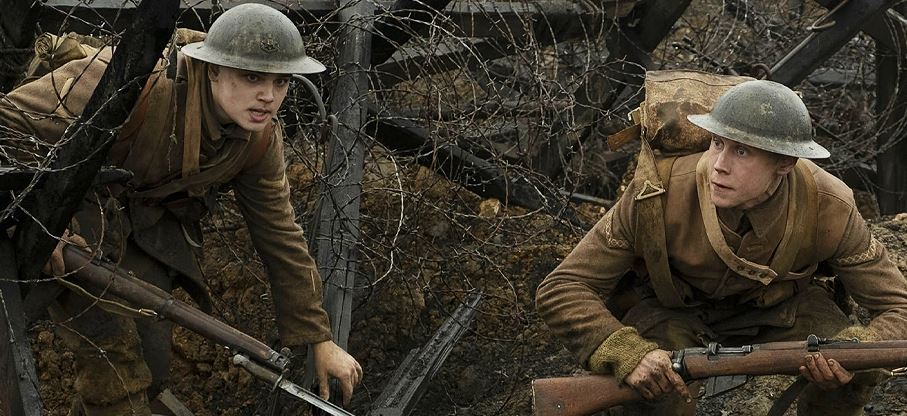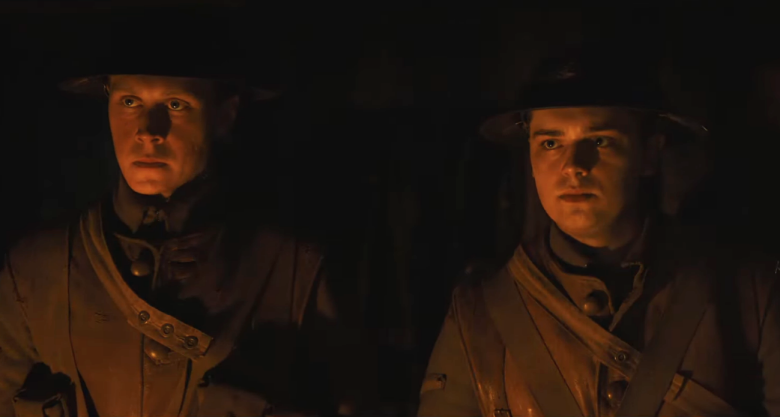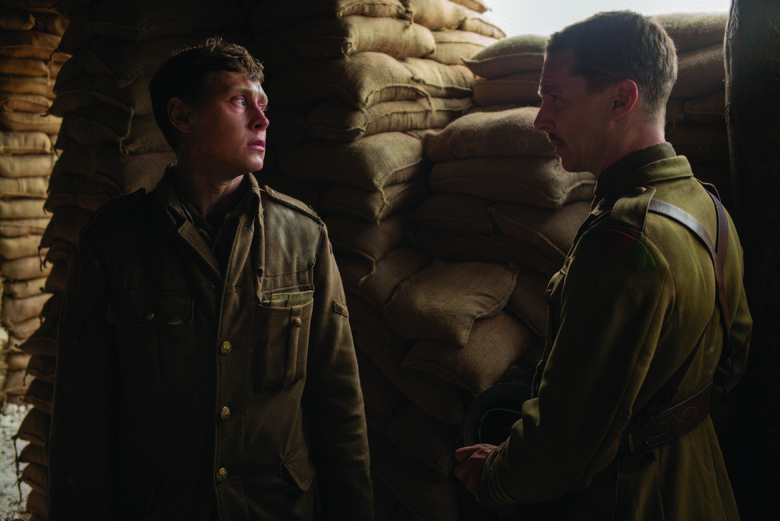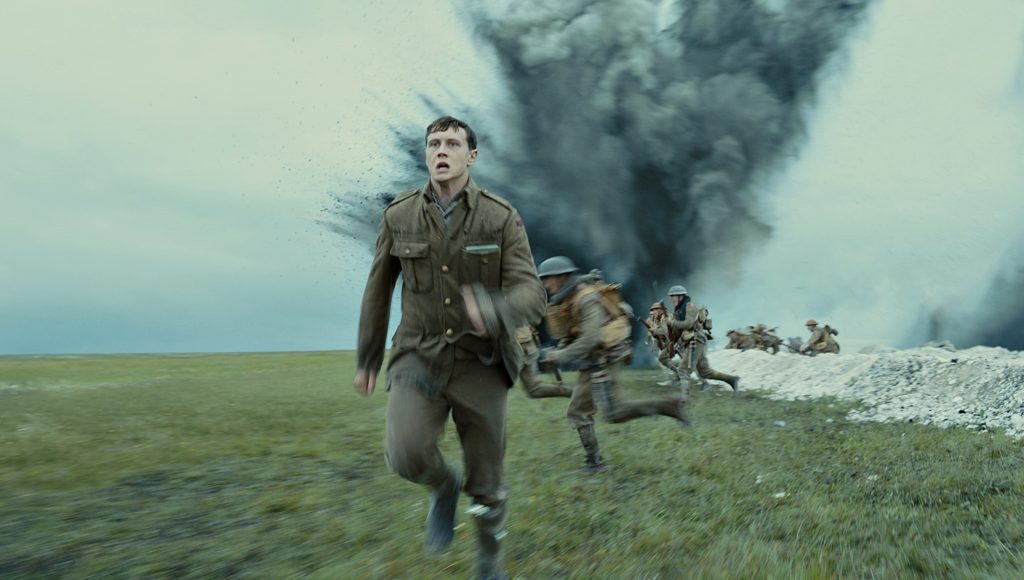
Two years ago, after 13 nominations without a victory, Roger Deakins—one of the greatest cinematographers who’s ever lived—won his first Oscar, for his magnificent work on Blade Runner 2049. I mention this not because I care about the Academy Awards (I don’t… except when I do), but because 1917, Sam Mendes’ bold and brawny and periodically breathtaking new film, seems to have been engineered specifically to secure Deakins an Oscar. Its technical premise—it purports to capture its grueling events in a single take—is not wholly novel; a recent example includes Birdman (which won Emmanuel Lubezki the second of his three straight trophies), while the conceit stretches back to Hitchcock and beyond. But in marrying the single-shot concept (or gimmick, depending on your disposition) to the epic gravity of the war picture, 1917 practically screams to be recognized for its grandeur. Some movies envelop you with the invisible pull of their craft; this one pulverizes you with the sheer force of its technique.
The single-take maneuver, though undeniably impressive, is not without its hazards. The risk of wielding the camera with such fluid dynamism is that it will distract viewers. It’s a danger of distancing; the more conscious you are of the stylistic prowess on display, the farther away from the screen you tend to feel, which in turn prevents you from melting into the immaculately constructed environments. But while my brain never quite stopped registering the presence of Deakins’ camera in 1917, that subconscious awareness did little to sabotage my appreciation of his work. There’s an elegance to his lensing, a grace that somehow magnetizes you, forcing you to grapple with the lovely brutality of his images. That distinctly cinematic paradox—the tension between horror and wonder, between ghastliness and gorgeousness, between death and life—is what animates 1917, and what makes it such a fascinating sit. Like most war movies, it traffics heavily in blood, viscera, terror, and despair. And it depicts this ugliness with what can only be called beauty.
Deakins is hardly the only skilled artisan in Mendes’ employ. Ever since he transitioned from the stage to the screen 20 years ago with American Beauty, the director has exhibited excellent taste in collaborators. 1917 isn’t exactly a throwback—its technique is too bracing to be conventional—but it nevertheless possesses a classical feel, a sort of old-Hollywood glamour wherein talented craftspeople have come together to create something on a mammoth scale. Much like with Deakins’ constantly roving camera, the effort from Mendes’ other contributors is simultaneously palpable and immersive. The production design, by Dennis Gassner (who also worked on Blade Runner 2049), is spectacular, conveying the horrific banalities of trench warfare with every slat of rough-hewn wood. The costumes, by David Crossman (Solo, Rogue One) and the great Jacqueline Durran (Little Women, Darkest Hour), reinforce the depressing uniformity of combat, where identically dressed men are destined to meet identical fates. And Thomas Newman’s score is arguably the film’s most emotive character, alternating between periods of restive quiet and explosive bombast.

That sense of vacillation is what most distinguishes 1917 from Dunkirk, its most obvious cinematic analogue. (Curiously enough, the two pictures share the same editor, Lee Smith.) Christopher Nolan’s landmark World War II thriller was notable for (among other things) its sheer relentlessness, the way it never paused to give you time to breathe; it also toyed with time, braiding three disparate strands into a complex mosaic. Mendes’ movie, which rewinds history by a few decades and one global conflict, is more traditional. It is a linear quest narrative, sending its principals off on a mission—a race against the clock, naturally—then watching as they evade obstacles and navigate peril. This means that it operates as a collection of set pieces—sequences of heart-pounding action and excruciating suspense—which are connected by more prosaic scenes of men walking, talking, and strategizing.
This is perhaps a natural byproduct of the single-shot format, which precludes Mendes from wielding the usual cinematic tools—you know, like editing—to help maintain momentum. Regardless, the intermittent lulls in the action—one involving a meet-up with a stalled convoy, another featuring a hushed encounter with a forlorn French refugee—feel like evident respites, intervals of apportioned calm before we get back to the good stuff. (It’s almost too convenient a metaphor that one of the convoy’s trucks literally gets stuck in the mud.)
Not that 1917 ever verges on tedious. For one thing, its setup is brisk and straightforward: Blake (Dean-Charles Chapman, best known as Tommen on Game of Thrones) and Schofield (George MacKay, Viggo Mortensen’s eldest son in Captain Fantastic) are lance corporals serving in northern France. When the film opens, they learn that 1,600 soldiers in a fellow regiment, including Blake’s brother, are fast walking into a German ambush. They’re thus tasked with crossing hostile territory—don’t worry, aerial surveillance photographs have revealed that it’s abandoned, we’re very certain of this—and rushing to the front to deliver orders to stop the Allied attack before they charge into a massacre.

The simplicity of 1917’s plot is hardly a drawback. The question is whether the story has enough meat on its finely sculpted bones to prevent it from feeling like a purely formal exercise, an excuse for Mendes to flaunt his virtuosity. The answer, much like the terrain that Blake and Schofield must trudge through, is somewhat muddy. It wouldn’t be fair to accuse 1917 of lacking a human dimension, given how regularly the script, by Mendes and Krysty Wilson-Cairns, pays tribute to the notions of honor, sacrifice, and loss. Yet despite its tone of respectful solemnity—one of its most striking scenes finds a platoon, readying for battle, stopping their preparations while a lone soldier croons the folk ballad “The Wayfaring Stranger”, a decidedly mournful pump-up song—the movie never acquires much depth at the level of character. Blake and Schofield are friends, sure, but while their banter is unforced, it’s never especially interesting. They function less as people than as support vehicles: a supply chain whose job it is to transport Mendes’ filmmaking gifts across many miles over the span of two continuously tracked hours.
Still, like most on-screen soldiers, they perform their duties admirably. 1917 may not articulate the terrible cost of war as effectively as it would like, but it nevertheless features a veritable trove of visual wonders. Deakins’ camera, with its smooth movement and unblinking eye, uncovers a number of discarded objects and creatures—a faded photograph, a child’s doll, an array of ashen skulls, a fly-infested horse—that come to collectively resemble artifacts of carnage. The colors are murky, mostly grey and brown, which only accentuates the fireballs of orange that arrive more steadily in the film’s second act. Throughout, Mendes presents everything with a brilliant blend of precision and pandemonium, a masterfully orchestrated medley of controlled chaos.

The primary recipient of this exquisite torment is Schofield, and while MacKay is given little to work with on the page, he nonetheless furnishes a quietly poignant performance, his face evoking disillusionment, resolve, and exhaustion, not to mention the omnipresent terror. (MacKay and Chapman are joined by a small company of estimable British actors; Mark Strong, Richard Madden, and Colin Firth all have short scenes, while Benedict Cumberbatch and especially Andrew Scott shine in brief moments.) His fear is thoroughly justified; Mendes subjects his weary fighters to a cavalcade of nightmares that are perversely imaginative in their variety. Each of his high-octane set pieces—a claustrophobic journey into a cave occupied by well-fed rats; a distant dogfight that turns into a close-range knife-fight (recalling Saving Private Ryan); a hectic scramble across a broken bridge, followed by a desperate leap into a river—is indecently watchable. That’s never more true than of the movie’s climax, a genuine pièce de résistance that doubles as a geometric marvel: a stunning sequence of Schofield sprinting across a prairie, perpendicular to the soldiers who charge past him from their trenches, artillery raining death on the whole helpless lot of them.
At one point in 1917, a cynical officer questions the consequence of Schofield and Blake’s mission, arguing that even if it’s successful, command will issue new orders soon enough, and thousands of soldiers will be sent to their graves regardless. He’s probably right. But that doesn’t make their endeavor meaningless, just as this movie’s accomplishments can’t be dismissed just because they’re aesthetic rather than emotional. 1917 won’t change how war films are made, even if it inspires copycats who attempt to mimic Mendes and Deakins’ high-concept craft. But it exists, in all its decadent glory; despite its flaws, it is a massive achievement. Or, to return to the idea of cinematic paradox: 1917 isn’t quite a great movie, but it’s still a movie full of greatness.
Grade: B+
Jeremy Beck is the editor-in-chief of MovieManifesto. He watches more movies and television than he probably should.
